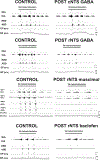GABA-ergic neurotransmission in the nucleus of the solitary tract modulates cough in the cat
- PMID: 29474953
- PMCID: PMC6261354
- DOI: 10.1016/j.resp.2018.02.009
GABA-ergic neurotransmission in the nucleus of the solitary tract modulates cough in the cat
Abstract
GABA, muscimol, and baclofen were microinjected into the rostral (rNTS) and caudal solitary tract nucleus (cNTS) in 24 anesthetized cats. Electromyograms (EMGs) of diaphragm (DIA) and abdominal muscles (ABD), blood pressure and esophageal pressure (EP) were recorded and analysed. Bilateral microinjections of 1 mM GABA (total 66 ± 4 nl), 1 mM baclofen (64 ± 4 nl) and unilateral microinjections of 0.5 mM muscimol (33 ± 1 nl) in the rNTS significantly reduced cough number (CN), amplitudes of ABD EMGs, expiratory EP, and prolonged the duration of the cough inspiratory phase. GABA microinjections decreased the amplitudes of cough-related DIA EMGs and inspiratory EP; muscimol microinjections decreased the cough DIA EMG on the contralateral side. Only microinjections of GABA into the cNTS suppressed CN. In some cases, microinjections prolonged the inspiratory phase, lowered respiratory rate, changed the depth of breathing, and increased blood pressure and heart rate. Our results confirm that GABA-ergic inhibitory mechanisms in the rNTS can regulate coughing in the anesthetized cat.
Keywords: Airway defense; Baclofen; Cough control; Microinjection; Muscimol.
Copyright © 2018 Elsevier B.V. All rights reserved.
Figures



Similar articles
-
Differential inhibition of cough by GABAA and GABAB receptor antagonists in the nucleus of the solitary tract in cats.Respir Physiol Neurobiol. 2023 Sep;315:104115. doi: 10.1016/j.resp.2023.104115. Epub 2023 Jul 17. Respir Physiol Neurobiol. 2023. PMID: 37460080
-
Role of the dorsomedial medulla in suppression of cough by codeine in cats.Respir Physiol Neurobiol. 2017 Dec;246:59-66. doi: 10.1016/j.resp.2017.07.011. Epub 2017 Aug 1. Respir Physiol Neurobiol. 2017. PMID: 28778649 Free PMC article.
-
Microinjection of kynurenic acid in the rostral nucleus of the tractus solitarius disrupts spatiotemporal aspects of mechanically induced tracheobronchial cough.J Neurophysiol. 2017 Jun 1;117(6):2179-2187. doi: 10.1152/jn.00935.2016. Epub 2017 Mar 1. J Neurophysiol. 2017. PMID: 28250153 Free PMC article.
-
gamma-Aminobutyric acid and cardiovascular function.Experientia. 1983 Aug 15;39(8):845-9. doi: 10.1007/BF01990401. Experientia. 1983. PMID: 6307735 Review.
-
[GABA and central regulation of cardiovascular function].J Pharmacol. 1985;16 Suppl 2:29-50. J Pharmacol. 1985. PMID: 2867251 Review. French. No abstract available.
Cited by
-
The role of neuronal excitation and inhibition in the pre-Bötzinger complex on the cough reflex in the cat.J Neurophysiol. 2022 Jan 1;127(1):267-278. doi: 10.1152/jn.00108.2021. Epub 2021 Dec 8. J Neurophysiol. 2022. PMID: 34879205 Free PMC article.
-
Peripheral antitussives affect temporal features of tracheobronchial coughing in cats.J Appl Physiol (1985). 2025 Jan 1;138(1):22-30. doi: 10.1152/japplphysiol.00551.2024. Epub 2024 Nov 19. J Appl Physiol (1985). 2025. PMID: 39561004 Free PMC article.
-
Connection Input Mapping and 3D Reconstruction of the Brainstem and Spinal Cord Projections to the CSF-Contacting Nucleus.Front Neural Circuits. 2020 Mar 31;14:11. doi: 10.3389/fncir.2020.00011. eCollection 2020. Front Neural Circuits. 2020. PMID: 32296310 Free PMC article.
-
Evidence for Alpha7 Nicotinic Receptor Activation During the Cough Suppressing Effects Induced by Nicotine and Identification of ATA-101 as a Potential Novel Therapy for the Treatment of Chronic Cough.J Pharmacol Exp Ther. 2022 Feb;380(2):94-103. doi: 10.1124/jpet.121.000641. Epub 2021 Nov 15. J Pharmacol Exp Ther. 2022. PMID: 34782407 Free PMC article.
-
Optogenetic stimulation of pre-Bötzinger complex reveals novel circuit interactions in swallowing-breathing coordination.Proc Natl Acad Sci U S A. 2022 Jul 19;119(29):e2121095119. doi: 10.1073/pnas.2121095119. Epub 2022 Jul 14. Proc Natl Acad Sci U S A. 2022. PMID: 35858334 Free PMC article.
References
-
- Berger AJ, Dick TE, 1987. Connectivity of slowly adapting pulmonary stretch receptors with dorsal medullary respiratory neuropns. J. Neurophysiol 58 (6), 1259–1274. - PubMed
-
- Berman AL, 1968. The Brain Stem of the Cat: A Cytoarchitectonic Atlas with Stereotaxic Coordinates, 1 ed. University of Wisconsin Press, Madison, Wisconsin.
-
- Bianchi AL, Gestreau C, 2009. The brainstem respiratory network: an overview of a half century of research. Respir. Physiol. Neurobiol 168, 4–12. - PubMed
MeSH terms
Substances
Grants and funding
LinkOut - more resources
Full Text Sources
Other Literature Sources
Medical
Miscellaneous

